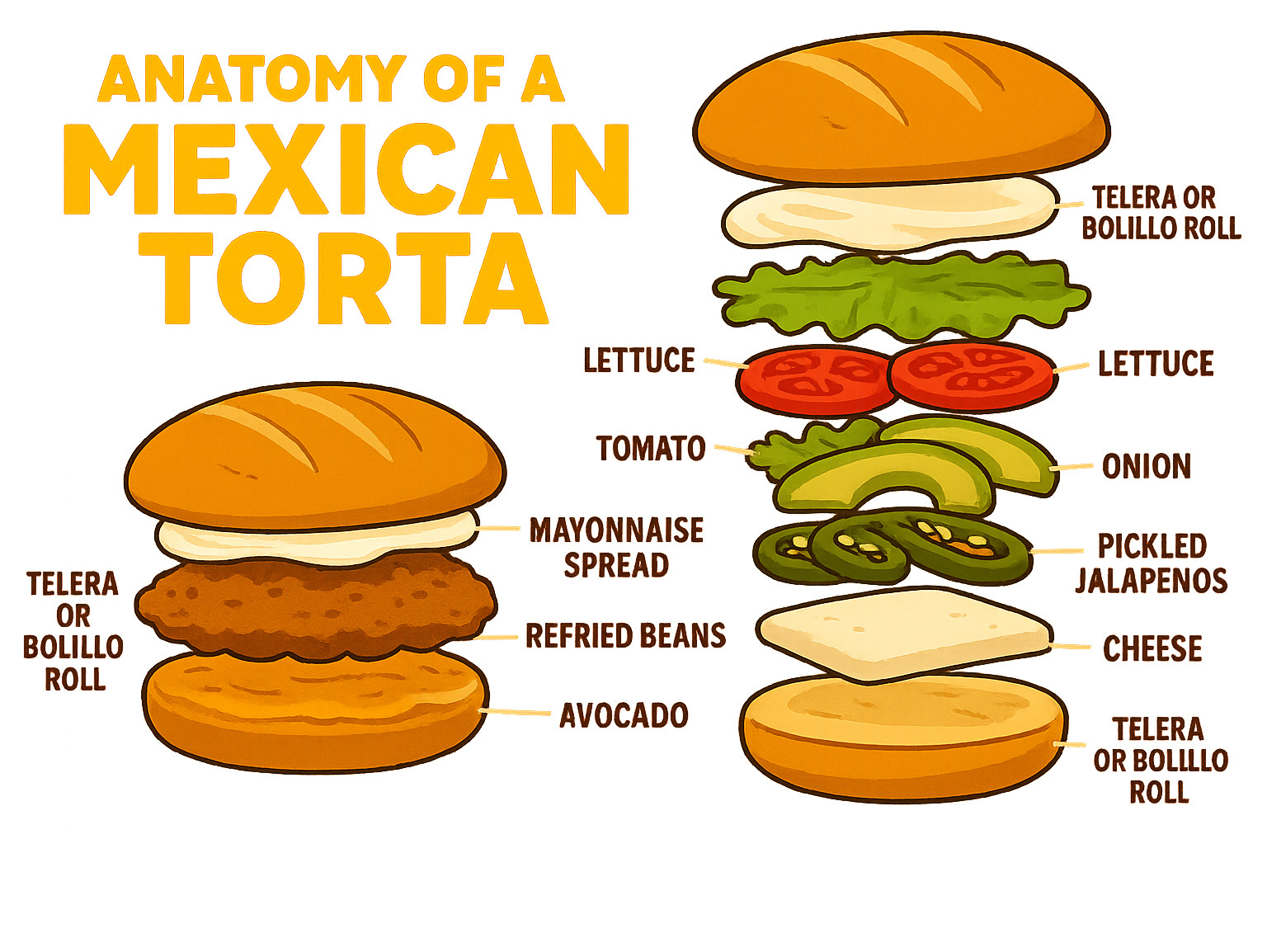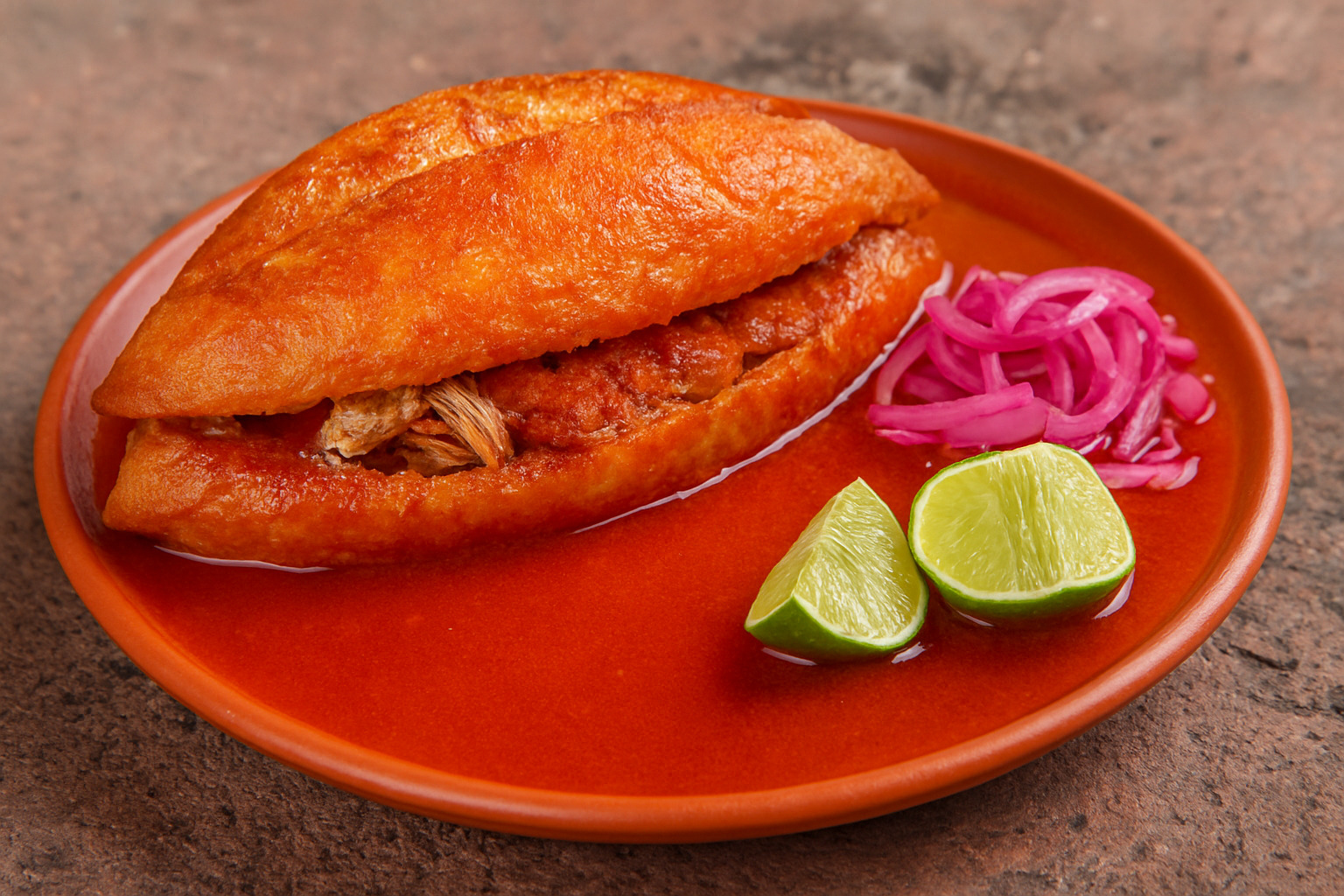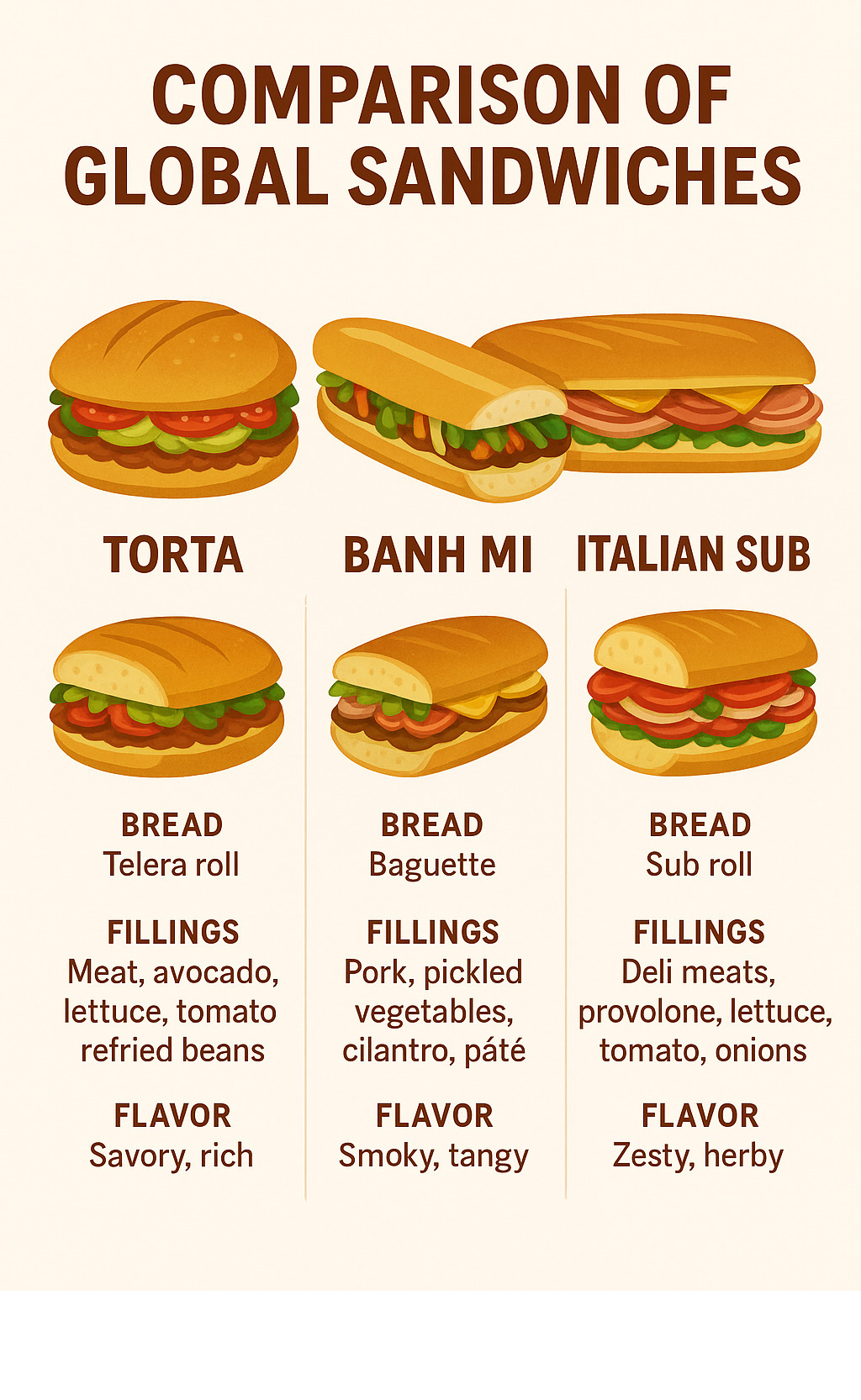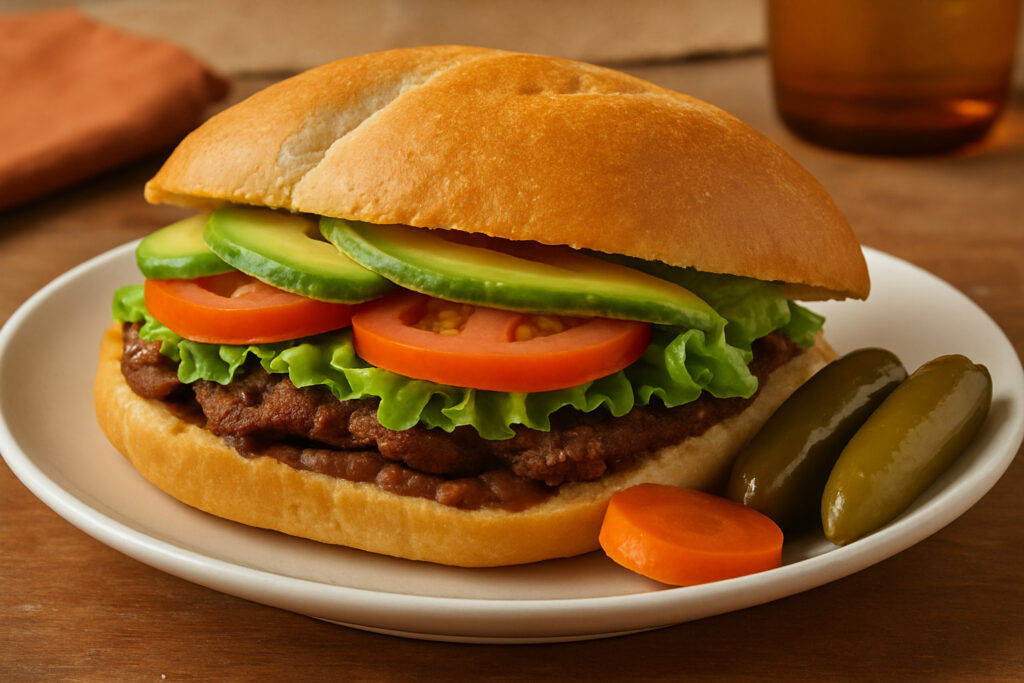The Ultimate Guide to Mexico’s Iconic Sandwich
Tortas are Mexican sandwiches made with soft yet crusty rolls (typically bolillo or telera bread) filled with a variety of ingredients including meats, beans, avocado, and various garnishes. They’re a beloved street food throughout Mexico and areas with large Mexican populations.
What is a Torta? Quick Answer:
| Feature | Description |
|---|---|
| Definition | A Mexican sandwich served on bolillo or telera rolls |
| Origin | Developed in the late 19th century, influenced by French baking during occupation |
| Common fillings | Milanesa (breaded cutlet), carnitas, chorizo, ham, beans, avocado |
| Regional varieties | Torta ahogada (Guadalajara), Torta cubana (Mexico City), Guajolota (Mexico City) |
| Where to find them | Torterías (dedicated shops), street vendors, Mexican restaurants |
The word “torta” has a fascinating culinary journey. While in Mexico it refers to these delicious sandwiches, in other Spanish-speaking countries the same word might mean cake, flatbread, or even omelet. This linguistic diversity reflects the rich cultural mix behind this seemingly simple food.
What makes tortas special is their perfect balance of textures and flavors. The slightly sweet, crusty bread provides the foundation, while fillings like seasoned meats, creamy avocado, tangy pickled jalapeños, and fresh vegetables create a symphony of taste in every bite.
As Rick Bayless, renowned chef and torta enthusiast explains: “What I love so much about the Torta… is that there are no rules.” This freedom of expression makes tortas both an authentic cultural tradition and an endlessly customizable culinary canvas.
Whether you’re grabbing one from a street vendor at a football match or crafting your own at home, tortas represent the vibrant, accessible spirit of Mexican cuisine that has captured hearts and stomachs worldwide.

Tortas terms explained:
Origins, Bread, and Anatomy of Tortas
Ever wonder how Mexico’s beloved sandwich got its name? The word torta comes from Late Latin “torta panis,” meaning “twisted bread” – a linguistic cousin to the English word “tart.” While the name has ancient roots, the sandwich we devour today has a more recent and fascinating history.
The torta as we know it emerged during the 1860s when French troops occupied Mexico. Those French soldiers brought more than just military might – they introduced European baking techniques that forever changed Mexican bread-making. In Puebla, local bakers accepted these methods but added their own Mexican flair, resulting in the creation of the essential torta foundations: bolillo and telera rolls.
These distinctive breads are what make a torta uniquely Mexican:
The bolillo is an oval-shaped roll with a crackling crust and pillowy interior – similar to a baguette but with its own character. The telera is softer and flatter, marked by two signature indentations that create three sections, with a subtle sweetness that complements savory fillings. In Guadalajara, the birote reigns supreme – a sourdough roll with the structural integrity to withstand being dunked in sauce for the famous tortas ahogadas.
What makes these breads special isn’t just their flavor, but their perfect texture – crusty enough to hold hefty fillings yet soft enough to yield with each bite. At Rick Bayless’s Chicago restaurant Xoco, they take torta bread seriously, slow-fermenting their dough for 12 hours to develop complex flavors.
Building a proper torta is an art form with specific architecture:
First comes the foundation – the bread split horizontally, sometimes with some interior removed to create a filling cavity. Next, a spread of refried beans or mayonnaise creates a crucial moisture barrier. The star protein follows – perhaps crispy milanesa, succulent carnitas, or smoky chorizo. Cheese adds creaminess, while fresh vegetables like avocado, lettuce, tomato, and onion bring brightness. The finishing touches? Zesty pickled jalapeños, fragrant cilantro, and punchy salsas.
What Does “Torta” Mean Around the World?
One word, many meanings – “torta” takes on different culinary identities depending on where you are:
In Spain, a “torta” typically refers to a flatbread made with baking powder instead of yeast. These were historically considered less desirable than proper bread, giving rise to the saying “A falta de pan, buenas son tortas” – essentially, “When bread isn’t available, tortas will do in a pinch.”
Travel to most of South America, and ordering a “torta” will get you dessert! In Argentina, Chile, and Uruguay, it’s what they call cake. Meanwhile, in the Philippines, “torta” might mean an omelet in Tagalog regions, while in Visayas and Mindanao, torta mamón is a unique sponge cake.
Cross over to Italy, and “torta” refers to pies or cakes with uniform, blended fillings, as opposed to “crostata” with its distinct pieces of fruit.
The Mexican Torta Sandwich: From Puebla to Nationwide Fame
The Mexican torta as we know it today was born in Puebla following the French occupation (1862-1867). Local bakers had absorbed French techniques but adapted them to Mexican tastes and ingredients. The telera roll – now synonymous with tortas – first emerged in Puebla during this beautiful culinary fusion.
Local legend tells us that the first commercial torta appeared in 1892, created by an enterprising eleven-year-old named Armando Martínez Centurión, who opened what may have been the first tortería. By the early 20th century, tortas had established themselves in Mexico City and were rapidly conquering the entire country.
Why Tortas Became Mexico’s Favorite Street Food
The torta rose to street food stardom for several practical reasons:
Their portability is best – sturdy bread contains all ingredients securely, allowing you to eat while walking without creating a mess. Their affordability made them accessible to everyone – using bread as a base provided an economical way to stretch ingredients into a satisfying meal.
The incredible versatility of the torta format lets vendors offer countless combinations while maintaining efficiency. And unlike tacos that demand immediate consumption, tortas can be prepared ahead of time without becoming soggy, giving them remarkable durability for busy food service.
These practical advantages made tortas the perfect food for massive gatherings like football matches, parades, and concerts. Today, torta vendors are fixtures at such events, feeding thousands of hungry attendees with these perfectly portable packages of flavor.
Regional & Specialty Tortas Across Mexico
Mexico’s diverse culinary landscape has given birth to an incredible variety of regional tortas, each telling its own delicious story of local ingredients and traditions. As you travel through different Mexican states, you’ll find how this seemingly simple sandwich transforms to reflect the unique character of each region.

The Spicy Legend of the Torta Ahogada
If you’ve ever visited Guadalajara, you’ve likely encountered their famous “drowned sandwich” – the torta ahogada. This fiery creation features tender carnitas (slow-cooked pork) tucked into a birote salado, a crusty sourdough roll that’s unique to the region. What makes this sandwich truly special is its dramatic finale: the entire creation gets dunked (or “drowned”) in a vibrant chile de árbol sauce.
The birth of this beloved sandwich has all the elements of a great food story. As local legend has it, sometime in the early 1900s, a sandwich vendor accidentally dropped a freshly made carnitas torta into a container of salsa. Rather than toss it out, they served it anyway – and customers went wild for the spicy, saucy creation.
The secret to a proper torta ahogada lies in that special birote roll. Its sourdough composition and sturdy crust allow it to soak up the sauce without turning to mush. Locals have their own spice-level language: ask for “media ahogada” (half-drowned) if you’re spice-cautious or “bien ahogada” (well-drowned) if you want the full, fiery experience.
Unlike its handheld torta cousins, this messy masterpiece demands a knife and fork, making it a sit-down street food experience. The combination of tangy bread, rich pork, and that signature spicy sauce creates something truly unforgettable.
Over-Stuffed Glory: Inside a Torta Cubana
Despite what its name might suggest, the Torta Cubana is a Mexico City invention with no real ties to Cuba. What makes this variety legendary isn’t its origin story – it’s the sandwich’s gloriously excessive nature. Imagine every meat in the tortería somehow crammed between two pieces of bread, and you’ve got the idea.
A proper Torta Cubana is a carnivore’s dream, typically featuring milanesa (breaded beef cutlet), ham, chorizo, pierna (roasted pork leg), cheese, egg, and sometimes even hot dogs. The result is what food writers have aptly described as a “football-sized” creation that challenges even the heartiest appetites.
The name’s origin remains a friendly debate among food historians. Some claim it was first served on Calle República de Cuba in Mexico City, while others believe it was created by a Cuban immigrant. Whatever the truth, the Torta Cubana perfectly captures the joyful excess that makes Mexican street food so beloved.
Cemita, Guajolota & More: Local Stars Worth Seeking
Beyond these famous varieties, Mexico’s regional torta landscape offers countless treasures worth hunting down:
The Cemita Poblana from Puebla is built on a stunning sesame-topped egg bread (also called cemita). What makes this sandwich sing is its distinctive combination of milanesa, pápalo (an aromatic herb with a unique flavor), smoky chipotle peppers, and stringy quesillo cheese. One bite of a cemita, and you’ll never mistake it for any other sandwich.
Mexico City breakfast-seekers cherish the Guajolota (also called Torta de Tamal) – a carb-lover’s dream that boldly stuffs an entire tamal inside a bolillo roll. It’s the ultimate comfort food that breaks all dietary rules in the most delicious way possible.
For the ultimate morning-after remedy, try a Torta de Chilaquiles, which brilliantly combines two beloved foods by stuffing chilaquiles (tortilla chips simmered in salsa with eggs) inside a telera roll. The textural contrast between the crunchy-soft tortilla bits and the pillowy bread creates something truly special.
The Pambazo features a guajillo chile-soaked roll filled with potatoes and chorizo, crisp lettuce, cool crema, and crumbly queso fresco. The distinctive red bread signals the spicy goodness waiting inside.
In northern Mexico, particularly around Guadalajara, you might hear tortas called “lonches” (derived from the English word “lunch”). These typically feature a crustier birote roll and fillings that reflect the region’s meat-forward cuisine.
And if you find yourself in León, Guanajuato, don’t miss the chance to try a Guacamaya – a crispy, crunchy celebration featuring chicharrón (pork rinds) as the star, often brightened with fresh pico de gallo and a generous splash of hot sauce.
Each of these regional specialties tells the story of its birthplace through bread, fillings, and preparation methods. They demonstrate how the humble torta has evolved across Mexico, adapted by creative cooks who transform this simple sandwich format into something that captures the essence of their local culinary traditions.
Tortas Beyond Borders: Comparisons & Evolution
When tortas packed their bags and traveled beyond Mexico’s borders, they didn’t just bring their delicious fillings—they brought their soul. Like any good traveler, these Mexican sandwiches have both influenced and been shaped by the cultures they’ve encountered, creating a beautiful culinary exchange.
The story of tortas in the United States began in the places you might expect—Texas, California, and Chicago, where large Mexican communities first introduced these handheld delights to their neighbors. Today, you’ll find tortas everywhere from humble food trucks to upscale restaurants.

How Tortas Stack Up Against Subs, Banh Mi, and Cubanos
When you place a torta next to other beloved global sandwiches, the differences reveal themselves in delightful ways:
Comparing with Italian subs, tortas nestle their fillings in softer, slightly sweet bolillo or telera rolls, while Italian subs demand a crusty, chewy bread. Tortas often begin with creamy spreads like beans and avocado that act as both flavor and structure, while subs focus on carefully layered meats and cheeses. Bite into a torta and you’ll taste bold Mexican chile heat and bright citrus notes; an Italian sub delivers the complex flavors of cured meats, vinegar tang, and Mediterranean herbs.
The Vietnamese banh mi and Mexican torta share a fascinating historical parallel—both were born when colonial French baking techniques collided with vibrant local food traditions. The banh mi celebrates contrast through its signature crackling-crisp baguette crust and pickled vegetables, while tortas achieve their textural magic through the interplay of creamy spreads, crunchy vegetables, and tender meats.
As for the Cuban sandwich—that pressed marvel of roast pork, ham, Swiss cheese, pickles, and mustard—it’s perhaps the most rule-bound of these sandwiches. Cubans must be pressed and grilled; tortas enjoy more freedom, appearing cold, toasted, or pressed depending on the variety. The bread differs too, with Cuban bread being lighter and less sweet than the torta’s telera or bolillo.
What makes tortas stand out in this global sandwich party is their remarkable adaptability without losing their identity. No matter how creative the fillings become, the specially designed bread and layered construction technique remain true to their Mexican roots.
The Rise of Gourmet Tortas in the United States
Something magical happens when talented chefs bring their expertise to street food classics. In recent years, tortas have made the journey from sidewalk stands to sophisticated restaurants, with Rick Bayless’s Tortas Frontera at Chicago’s O’Hare Airport standing as a shining example. It’s not every day an airport restaurant makes “best of” lists, but Tortas Frontera has been named among the Top Ten Airport Restaurants in America by both GQ Magazine and USA Today.
What makes these upscale tortas special while still honoring their humble origins? It starts with ingredients. Places like Tortas Frontera form partnerships with local farmers and producers to source sustainable meats, organic produce, and artisan breads. As Time Out Chicago noted with surprise: “An airport restaurant listing the local farms where its meat comes from? Unheard of…”
The bread itself receives special attention. At Xoco, Bayless’s bolillo rolls aren’t just any bread—they’re custom-developed by Labriola Baking Company and slow-fermented for 12 hours. This patience allows the dough to develop a gentle acidity and complex flavor that lifts everything placed between the slices.
Technique matters too. Watch a chef at a gourmet torta shop carefully carve out excess bread from the interior—not to skimp on ingredients, but to create the perfect bread-to-filling ratio and structural integrity. You might see them warming bread in wood-burning ovens rather than on flat-top grills, coaxing out subtle flavors that might otherwise remain hidden.
This evolution shows how traditional street food can grow and change while keeping its soul intact. As tortas continue gaining popularity across America, we’re witnessing innovation that respects tradition—the perfect recipe for culinary success.
Mastering Tortas at Home: Recipes & FAQs
Creating authentic tortas at home isn’t just possible—it’s a delicious trip anyone can start on. Even if traditional Mexican bread isn’t available in your neighborhood, you can still capture the magic of these iconic sandwiches with a few insider techniques.

Pro Tips for Building Flavor-Packed Tortas
The difference between a good sandwich and an unforgettable torta often comes down to technique. Here’s how the pros do it:
That soggy sandwich problem? Solved! Start by spreading refried beans on both sides of your bread. This creates a moisture barrier that keeps juices from turning your bread into a sad, soggy mess.
Think about your build order too. Beans first, then cheese (which gets all melty against warm proteins), followed by your meats, and finally those crisp vegetables and zingy garnishes. This isn’t just about looks—it’s strategic sandwich architecture!
Before assembly, consider hollowing out some of that extra bread from the middle. This creates the perfect bread-to-filling ratio and gives your ingredients more room to shine.
Temperature management matters too. Have all your ingredients prepped and ready before building, ensuring hot elements stay hot and cool elements stay refreshingly crisp.
As Rick Bayless explains, “Quality tortas depend on four pillars: great bread, high-quality ingredients, solid sandwich construction, and custom salsas.”
Must-Try Recipes: Carne Asada, Milanesa, and Mushroom Tortas
Ready to put your torta skills to the test? These three recipes showcase the versatility of this Mexican favorite:
The Carne Asada Torta celebrates beautifully grilled, thinly sliced steak. Season your flank or skirt steak with Mexican spices, grill it to a perfect medium-rare, and let it rest before slicing against the grain. The key is building layers of flavor—beans spread on toasted telera bread, followed by cheese, those juicy meat slices, creamy avocado, crisp lettuce, tomato, and the essential pickled jalapeños. A squeeze of lime brightens everything.
For the Torta de Milanesa, you’ll be working with thin beef cutlets pounded even thinner, then breaded and fried to golden perfection. This crispy delight pairs wonderfully with the soft telera roll, especially when layered with creamy beans, fresh vegetables, and a drizzle of Mexican crema.
Don’t eat meat? The Woodland Mushroom Torta proves that vegetarian options can be equally satisfying. Inspired by Xoco’s famous version, this sandwich features mixed mushrooms sautéed with garlic and herbs until golden and flavorful. The earthy mushrooms pair beautifully with tangy goat cheese, peppery arugula, and creamy avocado, all brought together with a smoky chipotle salsa.
Frequently Asked Questions About Tortas
Q: What’s the best bread to use if I can’t find traditional telera or bolillo rolls?
A: Don’t worry if authentic Mexican bread isn’t available—Portuguese rolls, kaiser rolls, or even ciabatta can work beautifully. Look for bread with that magic combination: slightly crisp exterior with a soft, pillowy interior.
Q: Are tortas always served hot?
A: Not at all! While tortas with fried fillings like milanesa are typically served warm, many varieties with cold cuts or vegetarian fillings are perfectly delicious at room temperature.
Q: How do I prevent my torta from getting soggy?
A: The bean barrier is your best friend here! Spread refried beans on both sides of your bread first to create a moisture shield. Toasting your bread before assembly also helps.
Q: What makes a torta different from a regular sandwich?
A: Three elements make a torta distinctive: the specific bread (telera or bolillo), the layering technique (with beans and avocado as foundational elements), and the Mexican flavor profile featuring ingredients like jalapeños, cilantro, and traditional Mexican proteins.
Q: Are there vegetarian options for tortas?
A: Absolutely! Mexico has a rich tradition of meatless tortas including the egg-based torta de huevo, the cheese-forward torta de queso, the earthy torta de champiñones (mushroom), the unique torta de nopales (cactus paddle), and the simple yet satisfying torta de aguacate (avocado).
Q: How do I reheat leftover tortas?
A: For best results, deconstruct your torta, warming the bread and hot fillings separately before reassembling. Short on time? Wrap the entire sandwich in foil and heat in a 325°F oven for about 10 minutes.
Want to find more global street food treasures? Check out The Dining Destination’s street food tours for inspiration on your next culinary trip.
Conclusion
Our journey through tortas reveals much more than just a sandwich – it uncovers a rich mix of cultural fusion, regional pride, and culinary innovation. From their origins during the French occupation of Mexico to their current status as global street food stars, tortas exemplify how food evolves while maintaining its soul and character.
What makes tortas truly special is their remarkable balance of accessibility and complexity. They’re democratic food in every sense – equally beloved by construction workers and office executives – yet they contain sophisticated layers of flavors and textures that reward the attentive eater with each bite.
The regional variations we’ve explored showcase Mexico’s incredible culinary diversity. Whether you’re savoring a sauce-drenched torta ahogada in Guadalajara, an impossibly stuffed torta cubana in Mexico City, or a sesame-topped cemita in Puebla, you’re experiencing a unique expression of local traditions.
As tortas continue their journey beyond Mexico’s borders, they’ve joined a global conversation about sandwich culture, both influencing and being influenced by other traditions. Chef-driven interpretations demonstrate how traditional street food can be respectfully liftd without losing the authentic spirit that makes it special.
At The Dining Destination, we believe that understanding food means understanding people. Tortas offer a delicious lens through which to explore Mexican history, regional differences, and the beautiful adaptability of culinary traditions. Whether you’re planning your next trip to Mexico or hoping to recreate these flavors in your own kitchen, we hope this guide has deepened your appreciation for this iconic sandwich.
The next time you bite into a well-made torta, take a moment to notice how each element contributes to the whole – the slightly sweet bread, the creamy avocado, the savory meat, the bright pop of pickled jalapeños. In that perfect bite, you’ll taste not just ingredients but history, innovation, and the joyful spirit of Mexican street food culture.
For more culinary trips and global food insights, explore our restaurant guides and street food tours. ¡Buen provecho!







